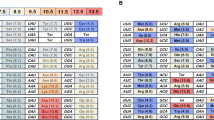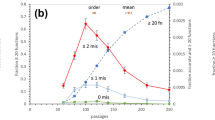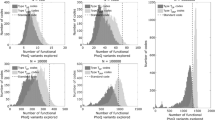Abstract
Error minimization (EM) of the standard genetic code (SGC) refers to the assignment of amino acids to codons in such a way that the deleterious impact of mutations is reduced. The SGC is nearly optimal for the property of EM, compared to randomly generated codes, and prompts the question of how the property arose. Brute force searching of alternative genetic codes is unlikely to have occurred, given the high number of alternative codes. Therefore, a heuristic search of ‘code space’, the space of alternative codes, would have been necessary. Uncovering the nature of this heuristic search is key to understanding the evolution of the genetic code, and consequently the origin of life. Scenarios that rely on direct selection for the property of EM require codon reassignments to sample code space, but these are problematic mechanistically. Alternatively, it has been shown that EM may have emerged in a neutral fashion as a byproduct of the process of genetic code expansion. In this scenario, similar amino acids are added to similar codons via the gene duplication of tRNAs and aminoacyl-tRNA synthetases. Mimicking this process via simulation indeed produces high levels of EM in the resulting genetic codes. These observations imply that optimization has occurred by an alternative to direct selection, commonly viewed as the only form of evolutionary optimization followed in nature. I propose that the neutral emergence of EM produced by code expansion is a genetic algorithm but unlike direct selection, the local selection criterion (amino acid and codon similarity) is distant from the global fitness function (EM), leading to the emergent optimization of EM. By presenting this counter example I clarify how evolutionary optimization in biological systems is not restricted to direct selection, and emphasize that additional processes may lead to the production of beneficial traits, via ‘non-Darwinian optimization’.


Similar content being viewed by others
Abbreviations
- EM:
-
Error minimization
- SGC:
-
Standard genetic code
- aaRS:
-
Aminoacyl-tRNA synthetase
- RRT:
-
Record to record travel
- GA:
-
Genetic algorithm
References
Alff-Steinberger C (1969) The genetic code and error transmission. Proc Natl Acad Sci USA 64:584–591
Archetti M (2004) Selection on codon usage for error minimization at the protein level. J Mol Evol 59:400–415
Bergthorsson U, Andersson DI, Roth JR (2007) Ohno’s dilemma: evolution of new genes under continuous selection. Proc Natl Acad Sci USA 104:17004–17009
Bilgin T, Kurnaz IA, Wagner A (2013) Selection shapes the robustness of ligand-binding amino acids. J Mol Evol 76:343–349
Bornberg-Bauer E, Chan HS (1999) Modelling evolutionary landscapes: mutational stability, topology and superfunnels in sequence space. Proc Natl Acad Sci USA 96:10689–10694
Buhrman H, van der Gulik PT, Kelk SM, Koolen WM, Stougle L (2011) Some mathematical refinements concerning error minimization in the genetic code. IEEE/ACM Trans Comput Biol Bioinform 8:1358–1372
Buhrman H, van der Gulik PTS, Klau GW, Schaffner C, Speijer D, Stougie L (2013) A realistic model under which the code is optimal. J Mol Evol 77:170–184
Butler T, Goldenfeld N, Mathew D, Luthey-Schulten Z (2009) Extreme genetic code optimality from a molecular dynamics calculation of amino acid polar requirement. Phys Rev 79:060901
Cavalcanti ARO, De Barros Neto B, Ferreira R (2000) On the classes of aminoacyl-tRNA synthetases and the error minimization in the genetic code. J Theor Biol 204:15–20
Codoner FM, Daros J, Sole RV, Elena SF (2006) The fittest versus the flattest: experimental confirmation of the quasispecies effect with subviral pathogens. PLoS Pathog 2:2136
Conant GC, Wolfe KH (2008) Turning a hobby into a job: how duplicated genes find new functions. Nat Rev Genet 9:938–950
Crick FH (1968) The origin of the genetic code. J Mol Biol 38:367–379
Cusack BP, Arndt PF, Duret L, Crollius HR (2011) Preventing dangerous nonsense: selection for robustness to transcriptional error in human genes. PLoS Genet 7:e1002276
de Oliveira LL, de Oliveira PSL, Tinos R (2015) A multiobjective approach to the genetic code adaptability problem. BMC Bioinform 16:52
De Visser JAGM et al (2003) Perspective: evolution and detetion of genetic robustness. Evolution 57:1959–1972
Di Giulio M (1989) The extension reached by the minimization of the polarity distances during the evolution of the genetic code. J Mol Evol 29:288–293
Di Giulio M, Medugno M (2001) The level and landscape of optimization in the origin of the genetic code. J Mol Evol 52:372–382
Di Giulio M, Capobianco MR, Medugno M (1994) On the optimization of the physicochemical distances between amino acids in the evolution of the genetic code. J Theor Biol 186:43–51
Dueck G (1993) New optimization heuristics: the great deluge algorithm and the record-to-record trave. J Comput Phys 104:86–92
Ellis N, Gallant J (1982) An estimate of the global error frequency in translation. Mol Gen Genet 188:169–172
Epstein CJ (1966) Role of the amino-acid “code” and of selection for conformation in the evoluiton of proteins. Nature 210:26–28
Fitch WM, Upper K (1987) The phylogeny of tRNA sequences provides evidence for ambiguity reduction in the origin of the genetic code. Cold Spring Harb Symp Quant Biol 52:759–767
Freeland SJ, Knight RD, Landweber LF, Hurst LD (2000) Early fixation of an optimal genetic code. Mol Biol Evol 17:511–518
Freeland SJ, Wu T, Keulmann N (2003) The case for an error minimizing standard genetic code. Origins Life Evol Biosphere 33:457–477
Gilis D, Massar S, Cerf NJ, Rooman M (2001) Optimality of the genetic code with respect to protein stability and amino-acid frequencies. Genome Biol 2:11
Goldberg AL, Wittes RE (1966) Genetic code: aspects of organization. Science 153:420–424
Goldman N (1993) Further results on error minimization in the genetic code. J Mol Evol 37:662–664
Goodarzi H, Nejad HA, Torabi N (2004) On the optimality of the genetic code, with consideration of termination codons. BioSystems 77:163–173
Gould SJ, Lewontin RC (1979) The spandrels of San Marco and the Panglossian paradigm: a critique of the adaptationist programme. Proc R Soc Lond B 205:581–598
Grantham R (1974) Amino acid difference formula to help explain protein evolution. Science 185:862–864
Higgs PG (2009) A four-column thoery for the origin of the genetic code: tracing the evolutioonary pathways that gave rise to an optimized code. Biol Direct 4:16
Judson OP, Haydon D (1999) The genetic code: what is it good for? An analysis of the effects of selection pressures on genetic codes. J Mol Evol 49:539–550
Kirkpatrick S, Gelatt CD, Vecchi MP (1983) Optimization by simulated annealing. Science 220:671–680
Knight RD, Freeland SJ, Landweber LF (1999) Selection, history and chemistry: the three faces of the genetic code. Trends Biochem Sci 24:242–247
Koonin EV, Novozhilov AS (2009) Origin and evolution of the genetic code: the universal enigma. IUBMB Life 61:99–111
Kurnaz ML, Bilgin T, Kurnaz IA (2010) Certain non-standard coding tables appear to be more robust to error than the standard genetic code. J Mol Evol 70:13–28
Lauring AS, Andino R (2010) Quasispecies theory and the behavior of RNA viruses. PLoS Pathog 6:e10010005
Lee S, Cho S (2001) Emergent behaviors of a fuzzy sensory-motor controller evolved by genetic algorithm. IEEE Trans Syst Man Cybern Part B 31:919–929
Lenstra R (2014) Evolution of the genetic code through progressive symmetry breaking. J Theor Biol 347:95–108
Marquez R, Smit S, Knight R (2005) Do universal codon-usage patterns minimize the effects of mutation and translation error? Genome Biol 6:R91
Massey SE (2006) A sequential ‘2-1-3’ model of genetic code evolution that explains codon constraints. J Mol Evol 62:809–810
Massey SE (2008) A neutral origin of error minimization in the genetic code. J Mol Evol 67:510–516
Massey SE (2010a) Searching of code space for an error minimized genetic code via Codon Capture leads to failure, or requires at least 20 improving codon reassignments via the Ambiguous Intermediate mechanism. J Mol Evol 70:106–115
Massey SE (2010b) Pseudaptations and the emergence of beneficial traits. In: Pontarotti P (ed) Evolutionary biology: concepts, molecular and morphological evolution. Springer, Berlin, pp 81–100
Massey SE (2015) Genetic code evolution reveals the neutral emergence of mutational robustness, and information as an evolutionary constraint. Life 5:1301–1332
Massey SE (2016) Neutral emergence of error minimized genetic codes superior to the standard genetic code. J Theor Biol 408:237–242
Massey SE (2017) The identities of stop codon reassignments support ancestral tRNA stop codon decoding activity as a facilitator of gene duplication and evolution of novel function. Gene 619:37–43
Massey SE, Garey JR (2007) A comparative genomics analysis of codon reassignments reveals a link with mitochondrial proteome size and a mechanism of genetic code change via suppressor tRNAs. J Mol Evol 64:399–410
McKay BD (2013) A note on the history of the four-colour conjecture. J Graph Theory 72:361–363
Mitchell M, Crutchfield JP, Das R (1996) Evolving cellular automata with genetic algorithms: a review of recent work. In: Proceedings of the first international conference on evolutionary computation and its applications. Russian Academy of Sciences
Morgens DW, Cavalcanti ARO (2013) An alternative look at code evolution: using non-canonical codes to evaulate adaptive and historic models for the origin of the genetic code. J Mol Evol 76:71–80
Nagel GM, Doolittle RF (1995) Phylogenetic analysis of hte aminoacyl-tRNA synthetases. J Mol Evol 40:487–498
Najafabadi HS, Lehmann J, Omidi M (2007) Error minimization explains the codon usage of highly expressed genes in Escherichia coli. Gene 387:150–155
Novozhilov AS, Wolf YI, Koonin EV (2007) Evolution of the genetic code: partial optimization of a random code for robustness to translation error in a rugged fitness landscape. Biol Direct 2:24
Osawa S, Jukes TH (1988) Evolution of the genetic code as affected by anticodon content. Trends Genet 4:191–197
Osawa S, Jukes TH (1989) Codon reassignment (codon capture) in evolution. J Mol Evol 28:271–278
Pagan RF, Massey SE (2014) A nonadaptive origin of a beneficial trait. in silico selection for free energy of folding leads to the neutral emergence of mutational robustness in single domain proteins. J Mol Evol 78:130–139
Pokarowski P, Kloczkowski A, Nowakowski S, Pokarowska M, Jernigan RL, Kolinksi A (2007) Ideal amino acid exchange forms for approximating substitution matrices. Proteins Struct Funct Bioinform 69:379–393
Santos J, Monteagudo A (2010) Study of the genetic code adaptability by means of a genetic algorithm. J Theor Biol 264:854–865
Schultz DW, Yarus M (1994) Transfer RNA mutation and the malleability of the genetic code. J Mol Biol 235:1377–1380
Schultz DW, Yarus M (1996) On malleability in the genetic code. J Mol Evol 42:597–601
Sonneborn TM (1965) Degeneracy of the genetic code: extent, nature, and genetic implications. Vogel V, Bryson HJ (eds). Academic Press, New York
Stoletzki N, Eyre-Walker A (2007) Synonymous codon usage in Escherichia coli: selection for translational accuracy. J Mol Evol 24:374–381
Stoltzfus A, Yampolsky LY (2007) Amino acid exchangeability and the adaptive code hypothesis. J Mol Evol 65:456–462
van der Gulik PTS, Hoff WDJ (2011) Unassigned codons, nonsense suppression, and anticodon modifications in the evolution of the genetic code. J Mol Evol 73:59
van Nimwegen E, Crutchfield JP, Huynen M (1999) Neutral evolution of mutational robustness. Proc Natl Acad Sci 96:9716–9720
Wilke CO, Wang JL, Ofria C, Lenski RE, Adami C (2001) Evolution of digital organisms at high mutation rates leads to survival of the flattest. Nature 412:331–333
Woese CR (1965) On the evolution of the genetic code. Proc Natal Acad Sci USA 54:1546–1552
Woese C (1967) The genetic code: the molecular basis for genetic expression. Harper, New York
Wong JTF (1980) Role of minimization of chemical distances between amino acids in the evolution of the genetic code. Proc Natl Acad Sci USA 77:1083–1086
Xue H, Tong K, Marck C, Grosjean H, Wong JT (2003) Transfer RNA paralogs: evidence of genetic code-amino acid biosynthesis coevolution and an archaeal root of life. Gene 310:59–66
Zhang J (2003) Evolution by gene duplication: an update. Trends Ecol Evol 18:292–298
Acknowledgements
The author would like to thank Dr. Ivan Erill (Department of Biological Sciences, University of Maryland – Baltimore) for discussion regarding emergent scenarios of code expansion, Dr. Heeralal Janwa (Department of Mathematics, UPR) for discussion on the four color theorem and Dr. Julian Velev (Department of Physics, UPR) for advice on optimization algorithms.
Funding
This research did not receive any specific grant from funding agencies in the public, commercial, or not-for-profit sectors.
Author information
Authors and Affiliations
Corresponding author
Rights and permissions
About this article
Cite this article
Massey, S.E. How to ‘find’ an error minimized genetic code: neutral emergence as an alternative to direct Darwinian selection for evolutionary optimization. Nat Comput 18, 203–212 (2019). https://doi.org/10.1007/s11047-017-9669-3
Published:
Issue Date:
DOI: https://doi.org/10.1007/s11047-017-9669-3




